Warehouse Clearance Sale – Limited time only!
Office furniture: Then and Now
In the modern corporate world, we continue to spend a lot of our time still in our working environment. Whether it be the advancement in technology, architecture, or our working areas, there has been a significant shift in style. Most of the engineering achievements of modern times are from office space demands. Take either Central Park, the former BankWest Tower, Brookfield Palace or QV. 1 for example – major buildings that dominate the skyline of Perth were all built to accommodate offices and working spaces. The way we work in offices has been changing over time and so has the furniture we use.
Although the term dates back to Roman Empire era, it wasn’t until the 18th century when the modern definition of office was invented. The Admiralty office built in 1726 in the UK served the purpose of handling an overwhelming amount of paperwork created by the businesses in various trade routes across the world when British Empire was at its peak. It also included meeting rooms and board rooms as part of its office space.
Through the industrial revolution to digital revolution, we have come a long way on how offices run along with almost everything else including office furniture. Office environments in modern times not only adapt gender neutral practices but also a lot more emphasis on employees and their well being – which was like a dream a few decades ago when the only focus seemed to be employee productivity.

Office environments in modern times not only adapt gender-neutral practices but also puts emphasis on employees and their well being
While embracing different working styles and new approaches to productivity and efficiency, businesses have also adopted different types of furnishings along the way. Call it a demand of the time, or adaptation according to the modern form of connectivity and communication. Office furniture has never been like it is today.
Evolution Of Office Desks
Flat top desks with pigeonholes for documents and slots for ledgers were common in the 19th century as they were already in existence by the end of 17th century. Roll-top desks were becoming standard in office spaces by the beginning of the 20th century. As these desks show, offices continue to revolutionize themselves with new technology.
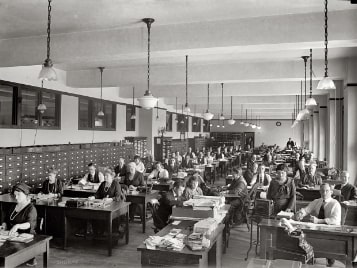
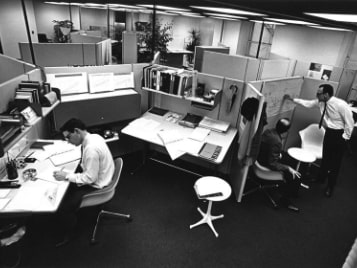

The introduction of typewriters to office desks from the early 20th century changed the way office desks looked. Bigger desks with drawers made from steel replaced the wooden desks commonly used at that time.
After the invention of the photocopier in 1949, office desks became smaller in size. Desks became smaller as they didn’t have to manage all the paper use. Part of the mainstream until the late 1960s, the small desks didn’t leave until fax machines made their way to standard office desks.
The invention and use of computers in offices transformed not only regular operations but also the working style of individuals. An American furniture designer proposed the idea of office cubicles. The designer thought it gave individual staff a bit of independence and autonomy in the 80s and 90s. However, that did not last long. The recession was forcing companies to downsize or merge. Due to this, companies began solving the issue of space with hot desks. With the introduction of laptops and flexible working, hot desks became popular among employees.
Ranging from standing desks to private desks, individuals have freedom to work according to their choice and schedules.
The concept of office desks and their design is totally different today. Companies are targeting more on individual employees and their workstyle as well as their health. Ranging from standing office desks to private desks, individuals have freedom to work according to their choice and schedules.
From Confinement To Flexible Workspaces
As time has gone on, modern workspaces are nothing like the workspace that Charles Lamb worked on during late 18th century at East India house in the UK from where much of British India was governed.
“Thirty years have I served the Philistines, and my neck is not subdued to the yoke. You don’t know how wearisome it is to breathe the air of four pent walls without relief day after day.”
The above words are from Charles Lamb’s letter, depicting what it was like working as a clerk in the late 18th century. Moreover, clerks of merchants during that time were treated like domestic servants. We have moved far from that point as far as office workspace and staff rights are concerned.
It is true that the employers of each era try their best to get the best productivity out of office spaces. Getting the most productivity is important to remain viable. However, there were never better office spaces in history as they are today.
From open plan office design to the workspace design according to the choice of the individual employee, there has been a lot of changes in the office workspaces.
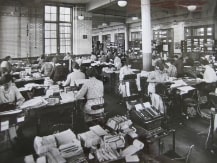
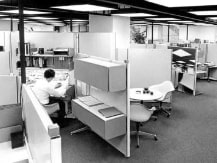

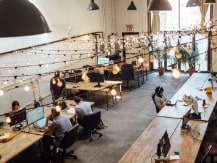

Twentieth century workspaces: From top right: Open plan, action office, cubicle workspace
Twenty-first century workspaces: From bottom right: Modern workspace, flexible workspace.
Highs And Lows Of Storage Furniture
From walls full of pigeon holes to a virtual world, the way we store documents has evolved over time. The need of storing documents and a place to store them soared with the use of paper documents in offices.
People were using individual desks as storage furniture at the beginning of the twentieth century. However, the need for storage furniture grew, thanks to the invention of the Xerox photocopier in 1949. Investments in filing cabinets, office cupboards, drawers, and lockers increased as physical bookkeeping became a crucial aspect of office operations.
The introduction of the digital era has seen companies go paperless; some supporting it as an eco-friendly practice. A totally paperless environment will probably be more commonplace in the future although. Offices still have a need to utilise physical files in their documentation.
Technology and Office Furniture
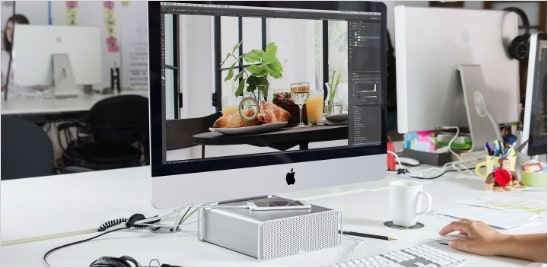
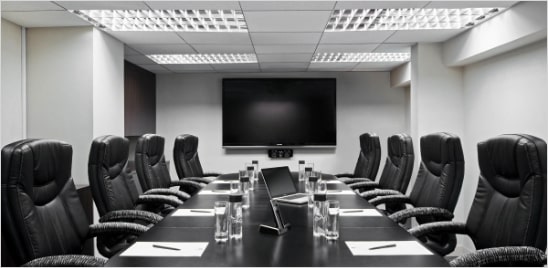
The modern ways of connectivity and communication were not even dreamt of when the first modern was becoming mainstream. But with time, office furniture has been supporting and adapting technology. With many employers realising that technology and functionality directly connect to productivity, companies are changing their focus. Technology is not only changing the way we work but also the furniture we install at our workspace.
From typewriters to computers and current technology, furniture designers have been busy designing furniture for technological advancements. The designing of office furniture is to meet the operational needs of offices. Moreover, since the beginning until now, designers are aiming to integrate employee satisfaction and well being.
We are on the verge of designing comfortable furniture instead of designing particular furniture for specific roles in today’s world. Thanks to technology, offices have moved to the virtual world of small portable devices. Employees are now free to choose their comfortable place to work.
Office Chairs: Not Just The Tools For Productivity
Designers were optimizing chairs only for productivity. It wasn’t until the mid-70s when designers began to think about the health and wellness of employees too.
The history of the office chair, dating back to Roman empire era, is very interesting. Design and the size of a chair would determine the personality and importance of the person who would be seated. The famous English naturalist, Charles Darwin, is credited to have started the idea of putting wheels on the office chair. Office chairs have been customised according to the needs of its user from the beginning. From wooden to mix of different materials over time, not only the materials that are used to manufacture office chairs have changed, but also the engineering behind it.
Office chairs have been customised according to the needs of its user from the beginning
Industrial revolution saw a growth in the number of employees in offices, and with growing trade activities, businesses began to look for ways that would help increase employee productivity.
Office chair provided better accommodations and helped workers experience less physical exhaustion. It wasn’t until late seventies when offices started to realise that productivity is also linked with the wellness of its staff. Though early posh ergonomic chair designs were only suitable for high level executives, they are being practiced more widely among other individuals in recent decades. Some companies have already installed massage chairs in their workspace to help employees reduce stress created by the work pressure.


Future Of Office Furniture
Industry leaders are predicting futuristic innovations like smart furniture and 3D printing will revolutionise the office furniture industry. As Forbes has already pointed out that ‘Rapid Liquid Printing’ could make it to the mainstream of the designing industry, such technology is sure to make a huge difference to everyone involved in the process of creating office furniture.
Few companies have already started to introduce sleep pods in their workspace as they are doing their best to make the office environment better than an employee’s home. This way, with increased work satisfaction, employees will be as productive as the office wants them to be.
With the advancement of technology, most offices in future would not require a physical office, but that does not mean there won’t be any work that would need physical accommodation. Workspaces will change and so will the way we work but the furniture to support us as we work will always be there, and will continue to adapt over time..
Office spaces have become an essential culture for humankind, and people expect this to continue for many years. The teamwork, the environment, and the execution of creative ideas together will remain as long as humankind will continue to move ahead with their values. People expect technology to make these values better but not vanish altogether.

Is your office furniture keeping up with the modern era ?
Most businesses do not follow the trend until it’s too late. Since it has been proved time and again that furniture you install at your office space directly affects the productivity of your employees, it is never a good idea to stay stuck in the past, not for the business at least. It is not just about personal space, desks or a particular design, but about the whole environment and culture that makes up your office space. Colors and curves and general aesthetics also affect the mood of your team. So you need to plan according to your operational style, business model and the needs of your team.
Direct Office provides the furniture that best fits your office and your team’s personality. From ergonomic chairs to modern-day workspaces, you can choose the modern-day furniture from various options that match your choice. Make a move for a better future today!
